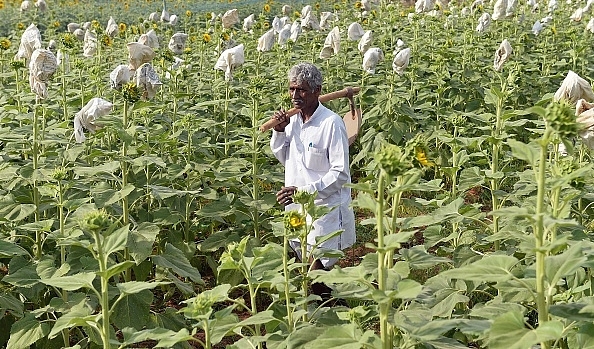Economy
Modi’s Dream Of Doubling Farm Incomes In The Next 5 Years Can Be Plausibly Achieved
- If the schemes that Mr. Modi has envisaged till now are implemented well, doubling of farm income by 2022 is possible. The budget is a positive step in that direction.

Farmer in field
The Finance Minister announced in the 2016 budget yesterday (29 Feb) that he wants “to double the income of the farmers by 2022”. This means that farm incomes need to go up by at least 10 percent annually on a CAGR (Compound Annual Growth Rate) basis for the next 6 years. The NITI Aayog Deputy Chairman Arvind Panagariya also expressed confidence, in an interview to CNN-IBN, that given the potential productivity gap in our farm sector, we can grow at this high growth rate in agriculture.
But our records speak a different story. India’s rural wages have never galloped this fast. The best we have had was the five-year period between 2007 and 2012 when rural wages grew at 6.8 percent.
Hence, the government needs to do different things, or maybe do the same things differently, to achieve the lift off velocity to reach its aims.
The big bane of Indian agriculture has been its over dependence on monsoon. More than 50 percent of cultivable land is still rain-fed.
Pradhan Mantri Krishi Sinchai Yojana has been given big importance in the budget. Prime Minister Narendra Modi promises to invest Rs 50,000 crore in irrigation projects over the next five years, with a special focus on modern water conservation techniques.
Previous irrigation projects were not successfull because they were not de-centralised enough, land acquisition was not factored in and projects were controlled by generalist bureaucrats not ground-water specialists. Moreover they became a money making machine for the local politicians. PMKSY is still in the implementation mode. Let’s hope lessons are learned and accountability is fixed.
The newly introduced Crop Insurance scheme promises to minimise the losses suffered by farmers. This should work as incentive to engage in agriculture activities. Other incentives for the farmer are numerous and substantial, contributing to raising farm income levels.
Soil Heath Card scheme is also getting the necessary implementation push. More than 1.13 crore Soil Heath Cards have been distributed as of 23 February. This is probably the first step taken towards the introduction of scientifically sound farming based on soil health.
Studies show that of all the possible ways of investing in rural India, the one with the highest multiplier effect is that of building all weather roads in poorly connected areas. Atal Bihari Vajpayee, in 2000, had started the Pradhan Mantri Gram Sadak Yojana but the UPA did not give it the required importance. Carrying the legacy of Vajpayee government forward, the budget has increased allocation to PMGSY three fold, from around Rs 8,000-9,000 crore to more than Rs 27,000 crore.
Kisan Vigyan Kendras (KVKs), the backbone of our agriculture extension system, have been neglected. The announcement of Rs 50 lakh worth competition will put in some competitive energy amongst them.
To reduce the burden of loan repayment on farmers, a provision of Rs 15,000 crore has been made in the budget towards interest subvention.
On the marketing side, the government seems to be in the process of ending the state level Agricultural Produce Marketing Commissions (APMCs). APMCs are socialist era bodies having a monopoly over the purchase of farm produce. This simply means that the farmers are duped into selling their produce at lower prices to the APMC rather than some other private trader who promises better prices. Jaitley announced that some 12 states have reformed their APMC laws. The government is incentivising other states to follow suit. A lot also depends on the progress of the Unified Agricultural Marketing e-Platform, which intends to unify all the mandis.
The last point in the chain of income earning for the farmer is procurement, both at remunerative prices and at the right time, just after harvesting. Although Minimum Support Prices (MSPs) are announced for all farm produce, it remains limited to rice and wheat procurement, that too in the Green Revolution areas i.e. Haryana, Punjab and Western Uttar Pradesh. This practice has distorted incentives, with farmers reluctant to diversify into other items such as horticulture, vegetables, pulses and oil-seeds. No surprises then, that food inflation has been high in most of these items.
What the NDA government has been trying to achieve is decentralised and transparent procurement by the states themselves, and diversification towards produce other than rice and wheat. In the last two years, for example, the hike in MSPs for rice and wheat has been low while hike in MSP of pulses and oil-seeds has been fairly large. The budget also focuses on the diversification of the farm sector with Rs 500 crore being allotted for enhancement of pulse production.
Introducing ElectionsHQ + 50 Ground Reports Project
The 2024 elections might seem easy to guess, but there are some important questions that shouldn't be missed.
Do freebies still sway voters? Do people prioritise infrastructure when voting? How will Punjab vote?
The answers to these questions provide great insights into where we, as a country, are headed in the years to come.
Swarajya is starting a project with an aim to do 50 solid ground stories and a smart commentary service on WhatsApp, a one-of-a-kind. We'd love your support during this election season.
Click below to contribute.
Latest